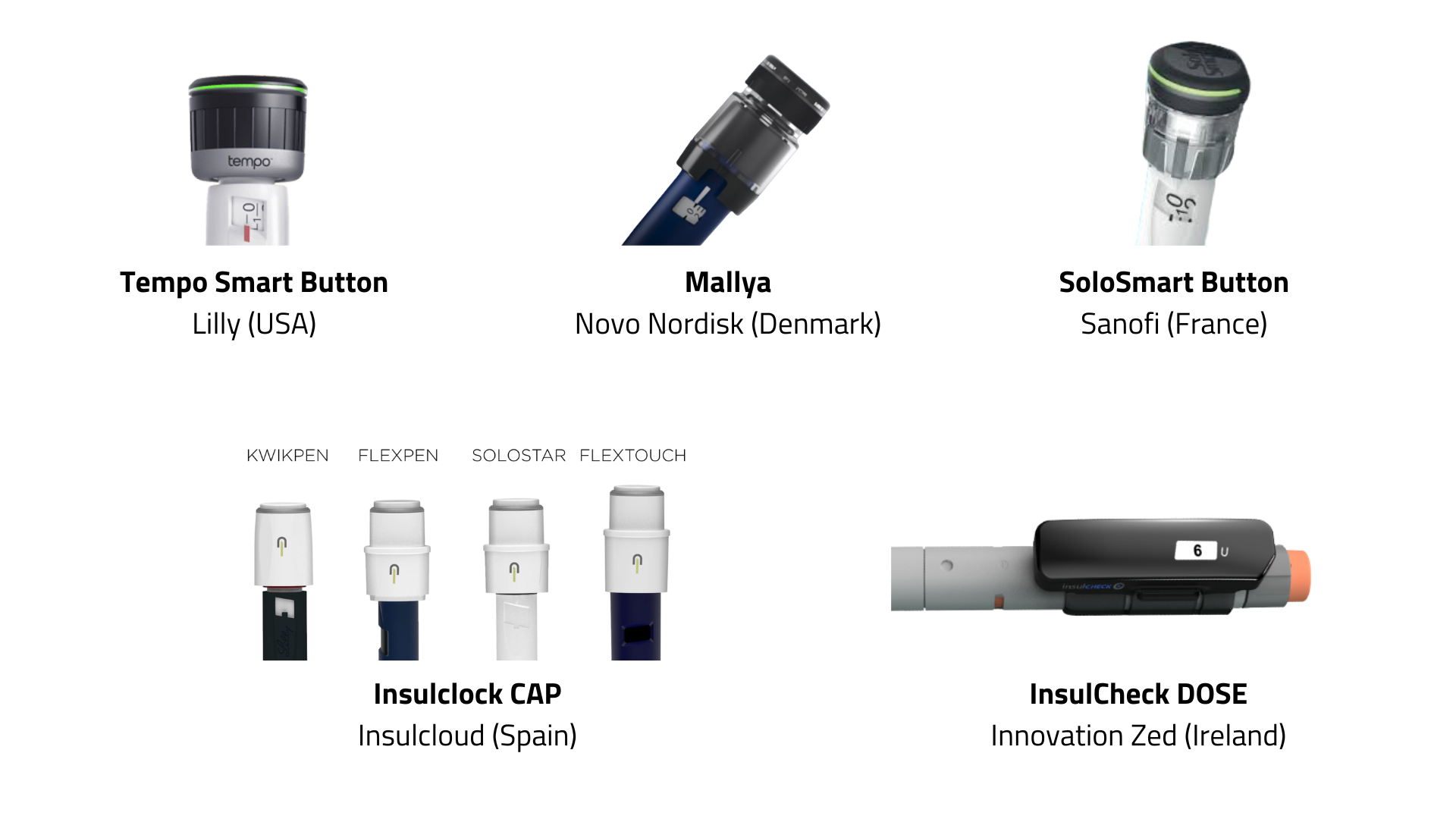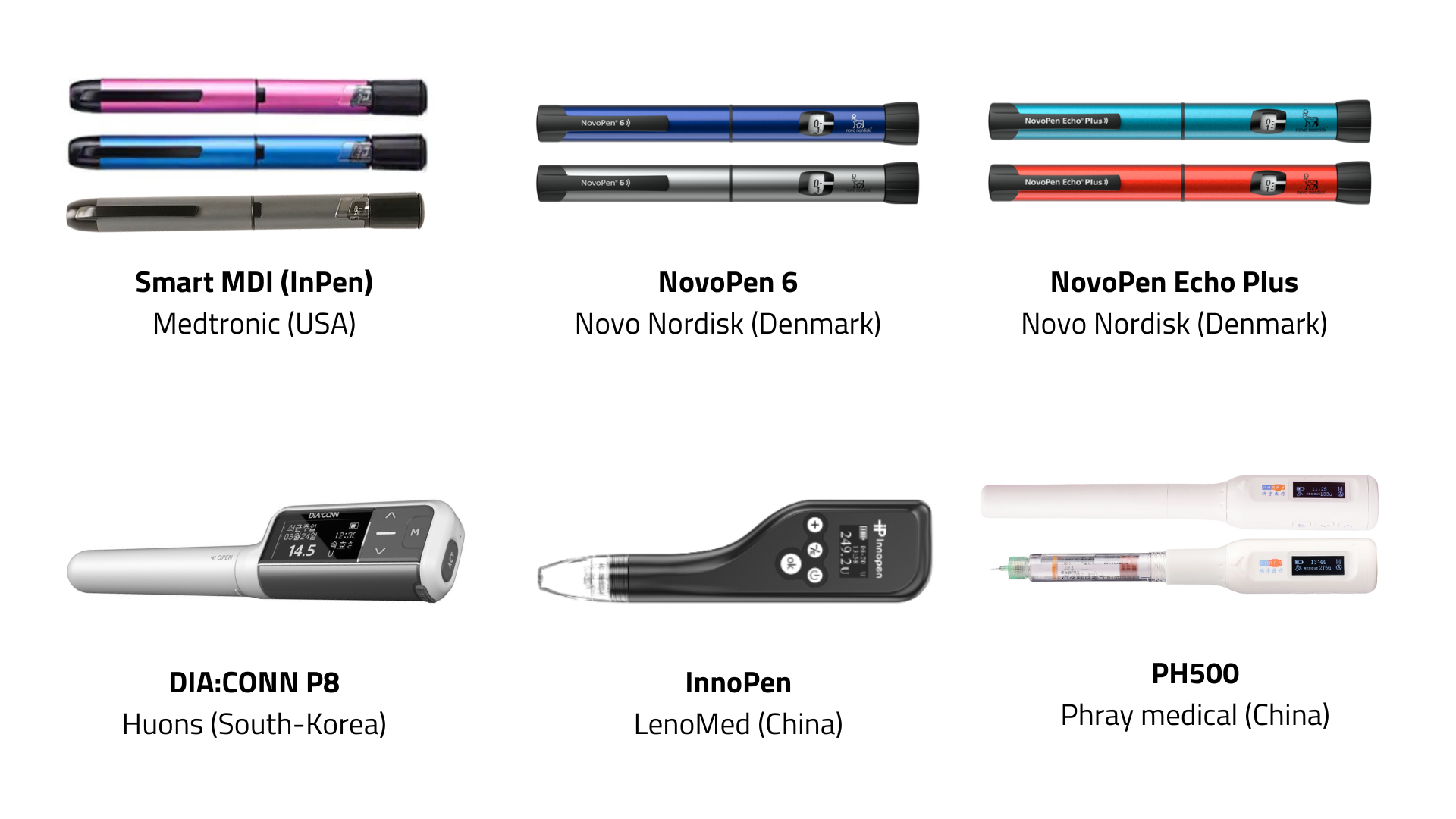Connected Insulin Pens and Smart Insulin Pen Systems
Nov 21, 2025
Insulin therapy is one of the most precise treatments in medicine.
In daily life, it is anything but precise.
A 2024 systematic review including 125,241 people with diabetes estimated that only about 55% of people on insulin are adherent to their prescribed regimen.
That means almost half of insulin users regularly:
- Miss doses
- Take insulin at a different time than prescribed
- Or inject a different amount than recommended
From a clinical point of view, this has two immediate consequences:
- A substantial part of “poor control” is likely due to missed or mistimed insulin, not “resistant diabetes.”
- Insulin titration is often based on incomplete information, because it is unclear which doses were actually given, and when.
This is the gap that connected insulin pens and “smart” insulin pen systems aim to fill.
-
Connected pens log and transmit insulin dose and timing to an app or cloud system. They show when the last dose was taken and how long ago it was given.
-
Smart insulin pen systems add real-time insulin dosing decision support—usually via an app—for bolus and sometimes basal insulin.
What current evidence actually supports
The ADA Standards of Care in Diabetes 2025 give a Grade B recommendation to offering connected insulin pens to people with diabetes on multiple daily injections.
This is based on several lines of evidence:
- People prefer connected pens over standard pens (Seo et al., 2023)
- Studies suggest that connected pens can increase TIR and reduce HbA1c (Adolfsson et al., 2020, Gomez-Peralta et al., 2023; Cranston et al., 2023)
- In a 2024 study, missing just 2 basal doses or 4 bolus doses over 14 days was associated with a >5% decrease in TIR (Danne et al., 2024)
So there is a consistent signal that connected pens may improve adherence and glycaemic outcomes.
At the same time, Carlson et al. (Clinical Therapeutics, 2025) offered a useful dose of realism:
"Smart insulin pens have shown increased TIR, fewer missed bolus injections and reduced HbA1c in small trials and prospective observational studies,
but large, multicenter randomized controlled trials comparing them with standard pens, vials and syringes are still lacking."
So while there is enough data to be interested in connected and smart insulin pen systems,
there is not enough data to be sure, across populations, over the long term, and at scale.
Real-world uptake reflects this:
- Payers are cautious.
- Many people with diabetes are reluctant to pay for a device on top of CGM, strips and everything else.
So right now, connected pens and smart insulin systems are clearly promising, but not yet a universal standard
What is actually on the market today?
1. Fixed connected insulin pens
Medtronic Smart MDI System (InPen)
The Medtronic Smart MDI system brings together three components:
-
A Medtronic CGM (Guardian or Simplera today, Instinct in the future)
-
The InPen smart insulin pen
-
The InPen app
Together, they provide real-time actionable alerts and insulin dosing guidance.
Users in the US can still connect a Dexcom CGM, but only with a 3-hour delayed glucose trace in the InPen app. To access full Smart MDI functionality in real time, Medtronic sensors are required.
The InPen is designed exclusively for rapid-acting insulin.
-
Europe: blue pen for Novo Nordisk rapid-acting insulin; grey pen for Lilly rapid-acting insulin
-
US: blue, grey, and pink versions for rapid-acting insulin from both Novo Nordisk and Lilly
Key system features:
-
Automatic dose logging
-
Integrated bolus calculator
-
Missed Dose Alert is triggered by rising glucose without a recent rapid-acting dose
-
Correct High Alert is triggered when glucose is elevated and active insulin is insufficient
-
Insight reports that allow to interpret basal and bolus patterns fast
-
Automatic detection of priming doses
-
Temperature monitoring
A recent study of 1,852 Smart MDI users showed that when individuals responded within one hour to more than 75% of alerts, Time in Range increased from 55.7% to 71.5%.
This demonstrates that timely, actionable alerts can meaningfully improve glucose outcomes.
Medtronic Diabetes Care (MiniMed) is currently running multiple studies to further evaluate the effectiveness of the Smart MDI system versus usual care in people with type 1 and type 2 diabetes.
NovoPen 6 and NovoPen Echo Plus
The NovoPen 6 and NovoPen Echo Plus are currently the most widely used connected pens worldwide.
They work with all Novo Nordisk Penfill insulins
- NovoPen 6 delivers full units (blue or grey)
- NovoPen Echo Plus delivers half units (red or turquoise)
On the pen itself you see the last insulin dose and the time since the last dose.
This insulin data is stored in the pen and transmitted only when scanned via NFC.
The pens can be read by: the Glooko Mobile app, mySugr, LibreLink (FreeStyle Libre 2 in certain regions), Dexcom G7 app and Glooko transmitter devices.
Novo Nordisk does not offer one universal app for all users.
However in some markets, the Dose Check app adds a basal titration module for people with type 2 diabetes on basal-only insulin (for example, Saudi Arabia in 2024)
DIA:Conn P8
The DIA:Conn P8 is heavily promoted in Korea and relatively unknown elsewhere.
- Works with insulin drawn from vials into dedicated cartridges
- Connects to the DIA:Conn app, which includes a bolus calculator
A recent randomized controlled trial in 42 adults on basal–bolus insulin and CGM showed improved TIR and reduced time below range with DIA:Conn P8 versus control.
This is a positive signal, but from a small cohort and a single market.
InnoPen and Phray PH500
The InnoPen and Phray PH500 are manufactured in China and sold online (e.g. Amazon) for around 150–200 EUR.
- They show the last dose and time on the pen,
- and seem to work with multiple insulin cartridges
BUT CE-marking is unclear, there is no FDA approval and GDPR-grade data protection is not guaranteed
For European and many other health systems, that combination makes them legally and clinically risky to recommend.
2. Connected insulin pen caps that replace the standard disposable cap at the top of the pen

Bigfoot Unity
Bigfoot Unity is a US-only system today.
- White caps are used for rapid-acting insulin
- Black caps are used for long-acting insulin
The caps integrate with FreeStyle Libre 2 sensors.
For people on fixed bolus regimens, scanning the Libre 2 sensor allows the cap to display a recommended insulin dose that includes a correction component.
Since Abbott acquired Bigfoot in 2024, visible marketing has decreased.
The shift of Libre systems toward continuous, no-scan real-time viewing also raises the question of where Unity will sit in the long term.
DUKADA Sense
DUKADA Sense is a flexible/adaptive connected cap platform that detects both the time and the size of doses on injection pens.
It can be configured with or without a display and transfers dose data via Bluetooth to a partner app or digital ecosystem through a configurable API.
Sense is developed as a B2B solution for pen and pharma partners and is currently in the adoption phase.
3. Connected insulin pen caps that are mounted on the bottom of the pen

Tempo Smart Button
The Tempo Smart Button is part of Lilly’s broader digital ecosystem.
- Currently available only in the US.
- Designed for use with Tempo pens, which are not yet widely launched in Europe.
- Works with the dedicated TempoSmart App (bolus calculator + Dexcom CGM integration) and the Tempo Insights reporting platform.
Strategically, it strengthens Lilly’s insulin portfolio.
Mallya
Mallya, originally a French company and now owned by Novo Nordisk, is designed for broad integration with CGM and data platforms.
So far, commercial visibility has been limited. The hardware exists; how aggressively it will be rolled out is still an open question.
SoloSmart
Sanofi’s SoloSmart has been ready on paper for several years. Launch plans have been announced, postponed, re-announced, and postponed again.
It is likely that Sanofi will increase momentum when competition or internal strategy demands it.
Insulclock CAP
Insulclock CAP stands out because of its validation work (Gomez-Peralta 2019, Gomez-Peralta et al. 2020, Gomez-Peralta et al. 2024, Sotomayor et al. 2025, Gomez-Peralta et al. 2025):
- Different clips for different disposable pen types allow support for all major pens
- CE-marked and FDA-cleared
- Integrates with the Insulclock 360 app and the ENDO data platform
The main limitation is not the technology but access. It is not yet widely commercially available. From a clinician’s perspective, it is ready on paper; the question is when and where it will be routinely usable.
InsulChek DOSE
- Works with all disposable insulin pens
- Connects to its own app and the InsulChek SAOR platform
- Can integrate with Glooko
- Is actively seeking distribution partners
Again, the bottleneck is not the idea but execution and ecosystem.
Looking ahead – and a concrete next step
For now, it is reasonable to treat connected and smart insulin pen systems as:
- Targeted options for specific patients and settings where adherence, documentation and remote review are real issues
- Technologies in transition, gradually moving toward more integrated, algorithm-supported “Smart MDI” systems
- A space worth watching closely, because ongoing trials and product iterations will decide how they sit alongside pumps and classic pens in future guidelines
If you want to move beyond theory and actually see how a Smart MDI system behaves in practice — how the app looks, how alerts are triggered, what the reports show and where the limitations are — there is an obvious next step:
Kind regards,




